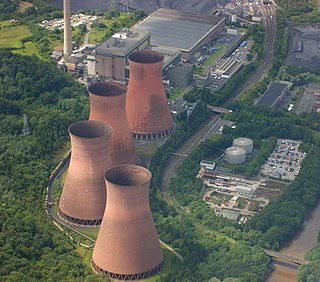Rugeley A (1961–1995)
| Rugeley power station A | |
|---|---|
 | |
| Country | England |
| Location | Rugeley |
| Status | Closed |
| Construction began | 1956 |
| Commission date | 1961 [3] |
| Decommission date | 1995 [4] |
| Operator(s) |
|
| Thermal power station | |
| Primary fuel | Coal |
| Power generation | |
| Nameplate capacity | 600 MW |
| External links | |
| Commons | Related media on Commons |
History
Construction of the A station started in 1956. [4] The station's generating sets were commissioned between 1961 and 1962. [5] The station was the first joint venture between the Central Electricity Generating Board (CEGB) and the National Coal Board (NCB). The station took coal directly from the neighbouring Lea Hall Colliery by conveyor belt. [4] This was the first such arrangement in Britain. The colliery was put into production some 6 months before the first generating unit was commissioned in the power station. The station was officially opened on 1 October 1963 by Lord Robens of Woldingham and Sir Christopher Hinton.
The first of the five cooling towers to be completed at Rugeley in 1960 was the world's first large dry cooling tower and the first large scale experiment with a design aimed at eliminating water loss. [4] The dry tower was commissioned in 1962 but its capital and operating costs were considerably higher than a conventional wet tower. No further dry towers were constructed in the UK. [6] On occasions this tower was used by the RAF for parachute development. Rugeley A was also the first power station in Britain to be controlled entirely from a central control room. [4] The total cost of building it was £30 million.
Design and specification
The station had five 120 MW generating sets which gave it a generating capacity of 600 megawatts (MW). The boilers operated on pulverised coal and delivered 540 kg/s of steam at 103.4 bar and 538 °C. [7] Rugeley A was one of the CEGB's twenty steam power stations with the highest thermal efficiency; in 1963–4 the thermal efficiency was 33.34 per cent, 31.75 per cent in 1964–5, and 31.42 per cent in 1965–6. [8] In 1980–1 the station sent out 2,612.838 GWh, the thermal efficiency was 29.56 per cent. [7] The annual electricity output of Rugeley A was: [7] [9]
| Year | 1960–1 | 1961–2 | 1962–3 | 1963–4 | 1964–5 | 1965–6 | 1966–7 | 1971–2 | 1978–9 | 1980–1 | 1981–2 |
|---|---|---|---|---|---|---|---|---|---|---|---|
| Electricity supplied, GWh | 119.2 | 1,379.2 | 2,873.1 | 3,361 | 3,058 | 2,953 | 3,309 | 2,544 | 2,633.9 | 2,612.8 | 2,433 |
| Thermal efficiency, % | 31.12 | 32.81 | 33.01 | 33.34 | 31.75 | 31.42 | 31.75 | 30.54 | 30.08 | 29.56 | 30.94 |
Closure
The closure of the A station began in 1994. Two of the station's generating units were decommissioned, with the other three following in 1995. [5] Having burned nearly 42 million tonnes of coal in its lifetime, [4] the station was demolished later in 1996. [1]
Statistics at closure
| First ran [5] | Closing date | Total run (hours) | Total starts | Total generation (GWh) | |
|---|---|---|---|---|---|
| Unit 1 | 1961 | 1994 | 196,049 | 3,719 (3,260 hot, 459 cold) | 20,097 |
| Unit 2 | 1961 | 1995 | 180,781 | 4,948 (4,577 hot, 371 cold) | 18,882 |
| Unit 3 | 1961 | 1995 | 154,621 | 4,220 (3,701 hot, 519 cold) | 15,912 |
| Unit 4 | 1962 | 1994 | 169,201 | 4,404 (3,997 hot, 407 cold) | 17,526 |
| Unit 5 | 1962 | 1995 | 168,670 | 3,817 (3,420 hot, 397 cold) | 17,261 |
Total coal burnt during lifetime: 41,869,969 tonnes

















